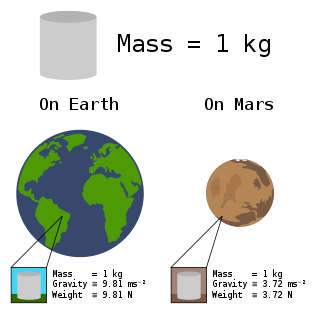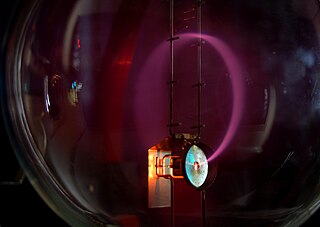Related Research Articles
A binary prefix is a unit prefix that indicates a multiple of a unit of measurement by an integer power of two. The most commonly used binary prefixes are kibi (symbol Ki, meaning 210= 1024), mebi (Mi, 220 = 1048576), and gibi (Gi, 230 = 1073741824). They are most often used in information technology as multipliers of bit and byte, when expressing the capacity of storage devices or the size of computer files.
Giga ( or ) is a unit prefix in the metric system denoting a factor of a short-scale billion or long-scale milliard (109 or 1000000000). It has the symbol G.

A physical quantity is a property of a material or system that can be quantified by measurement. A physical quantity can be expressed as a value, which is the algebraic multiplication of a numerical value and a unit of measurement. For example, the physical quantity mass, symbol m, can be quantified as m=n kg, where n is the numerical value and kg is the unit symbol.
The International System of Units, internationally known by the abbreviation SI, is the modern form of the metric system and the world's most widely used system of measurement. Established and maintained by the General Conference on Weights and Measures (CGPM), it is the only system of measurement with an official status in nearly every country in the world, employed in science, technology, industry, and everyday commerce.
A metric prefix is a unit prefix that precedes a basic unit of measure to indicate a multiple or submultiple of the unit. All metric prefixes used today are decadic. Each prefix has a unique symbol that is prepended to any unit symbol. The prefix kilo-, for example, may be added to gram to indicate multiplication by one thousand: one kilogram is equal to one thousand grams. The prefix milli-, likewise, may be added to metre to indicate division by one thousand; one millimetre is equal to one thousandth of a metre.
Standard temperature and pressure (STP) are various standard sets of conditions for experimental measurements to be established to allow comparisons to be made between different sets of data. The most used standards are those of the International Union of Pure and Applied Chemistry (IUPAC) and the National Institute of Standards and Technology (NIST), although these are not universally accepted standards. Other organizations have established a variety of alternative definitions for their standard reference conditions.

In science and engineering, the weight of an object is the force acting on the object due to acceleration or gravity.
The dalton or unified atomic mass unit is a non-SI unit of mass defined as 1/12 of the mass of an unbound neutral atom of carbon-12 in its nuclear and electronic ground state and at rest. The atomic mass constant, denoted mu, is defined identically, giving mu = 1/12 m(12C) = 1 Da.

In science and engineering, the parts-per notation is a set of pseudo-units to describe small values of miscellaneous dimensionless quantities, e.g. mole fraction or mass fraction. Since these fractions are quantity-per-quantity measures, they are pure numbers with no associated units of measurement. Commonly used are parts-per-million, parts-per-billion, parts-per-trillion and parts-per-quadrillion. This notation is not part of the International System of Units (SI) system and its meaning is ambiguous.
IEC 60027 is a technical international standard for letter symbols published by the International Electrotechnical Commission (IEC), comprising the following parts:
International standard ISO 1000 is the ISO standard describing the International System of Units (SI).
ISO 31-0 is the introductory part of international standard ISO 31 on quantities and units. It provides guidelines for using physical quantities, quantity and unit symbols, and coherent unit systems, especially the SI. It was intended for use in all fields of science and technology and is augmented by more specialized conventions defined in other parts of the ISO 31 standard. ISO 31-0 was withdrawn on 17 November 2009. It is superseded by ISO 80000-1. Other parts of ISO 31 have also been withdrawn and replaced by parts of ISO 80000.
IEEE 1541-2002 is a standard issued in 2002 by the Institute of Electrical and Electronics Engineers (IEEE) concerning the use of prefixes for binary multiples of units of measurement related to digital electronics and computing. IEEE 1541-2021 revises and supersedes IEEE 1541–2002, which is 'inactive'.
ISO 31-11:1992 was the part of international standard ISO 31 that defines mathematical signs and symbols for use in physical sciences and technology. It was superseded in 2009 by ISO 80000-2:2009 and subsequently revised in 2019 as ISO-80000-2:2019.

The mass-to-charge ratio (m/Q) is a physical quantity relating the mass (quantity of matter) and the electric charge of a given particle, expressed in units of kilograms per coulomb (kg/C). It is most widely used in the electrodynamics of charged particles, e.g. in electron optics and ion optics.

Quantities, Units and Symbols in Physical Chemistry, also known as the Green Book, is a compilation of terms and symbols widely used in the field of physical chemistry. It also includes a table of physical constants, tables listing the properties of elementary particles, chemical elements, and nuclides, and information about conversion factors that are commonly used in physical chemistry. The Green Book is published by the International Union of Pure and Applied Chemistry (IUPAC) and is based on published, citeable sources. Information in the Green Book is synthesized from recommendations made by IUPAC, the International Union of Pure and Applied Physics (IUPAP) and the International Organization for Standardization (ISO), including recommendations listed in the IUPAP Red Book Symbols, Units, Nomenclature and Fundamental Constants in Physics and in the ISO 31 standards.
ISO 80000 or IEC 80000, Quantities and units, is an international standard describing the International System of Quantities (ISQ). It was developed and promulgated jointly by the International Organization for Standardization (ISO) and the International Electrotechnical Commission (IEC). It serves as a style guide for using physical quantities and units of measurement, formulas involving them, and their corresponding units, in scientific and educational documents for worldwide use. The ISO/IEC 80000 family of standards was completed with the publication of Part 1 in November 2009.
The JEDEC memory standards are the specifications for semiconductor memory circuits and similar storage devices promulgated by the Joint Electron Device Engineering Council (JEDEC) Solid State Technology Association, a semiconductor trade and engineering standardization organization.
The International System of Quantities (ISQ) consists of the quantities used in physics and in modern science in general, starting with basic quantities such as length and mass, and the relationships between those quantities. This system underlies the International System of Units (SI) but does not itself determine the units of measurement used for the quantities.
The Joint Committee for Guides in Metrology (JCGM) is an organization in Sèvres that prepared the Guide to the Expression of Uncertainty in Measurement (GUM) and the International Vocabulary of Metrology (VIM). The JCGM assumed responsibility for these two documents from the ISO Technical Advisory Group 4 (TAG4).
References
- International Organization for Standardization (1993). ISO Standards Handbook: Quantities and units (3rd ed.). Geneva: ISO. ISBN 92-67-10185-4. (contains both ISO 31 and ISO 1000)
- Cohen, E. R.; Giacomo, P. (1987). "Symbols, Units, Nomenclature and Fundamental Constants in Physics (1987 Revision), Document IUPAP-25 (IUPAP–SUNAMCO 87–1)". Physica A . 146 (1): 1–68. Bibcode:1987PhyA..146D...9C. doi:10.1016/0378-4371(87)90215-9.